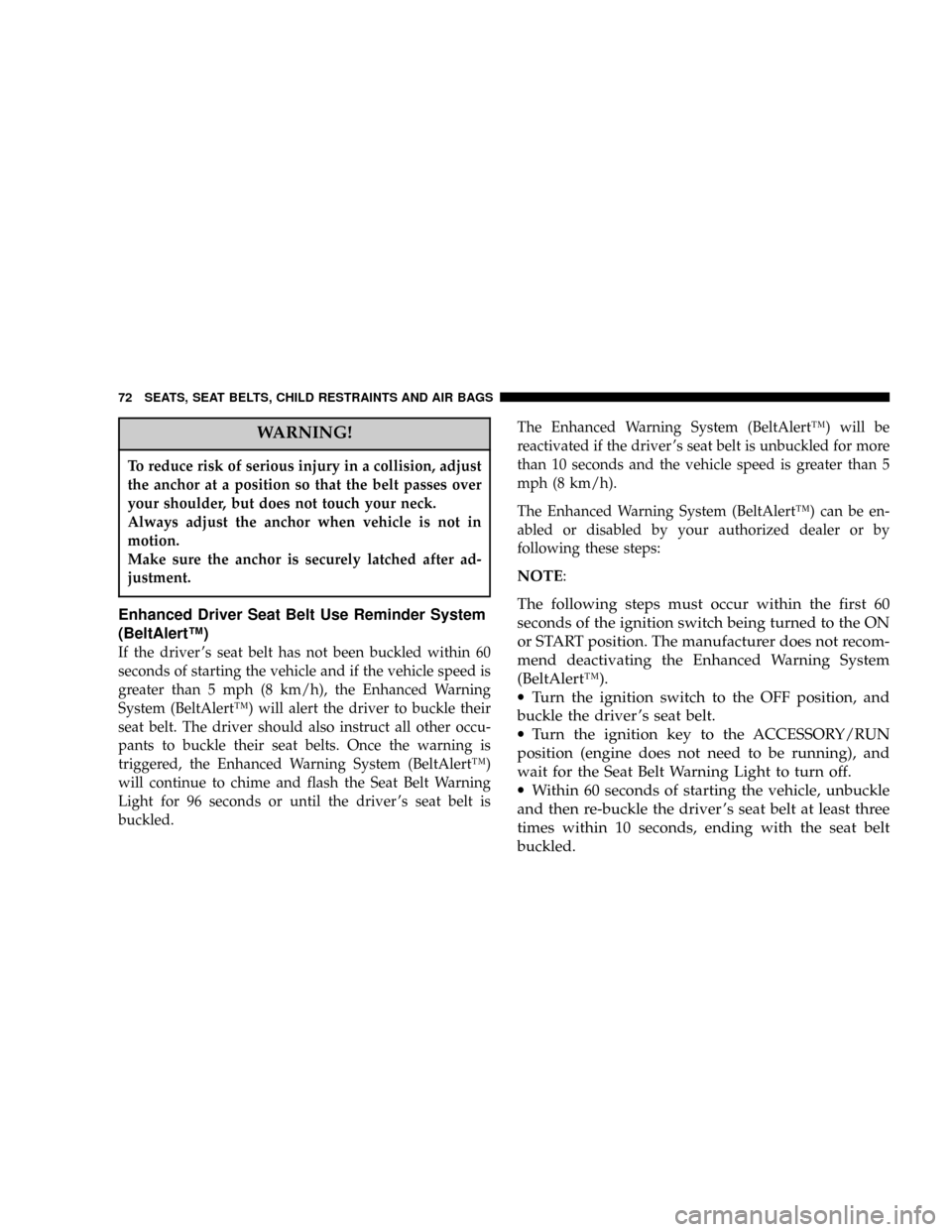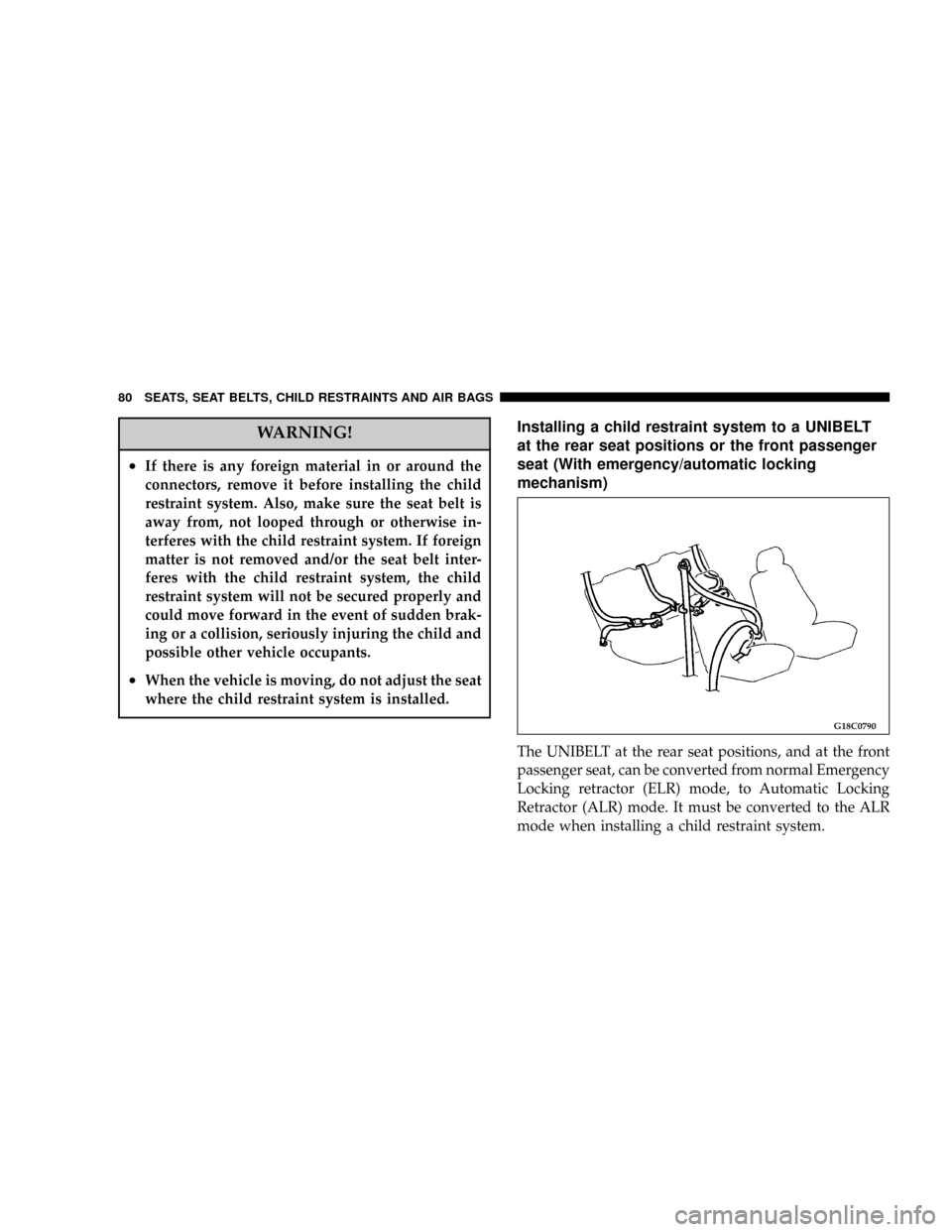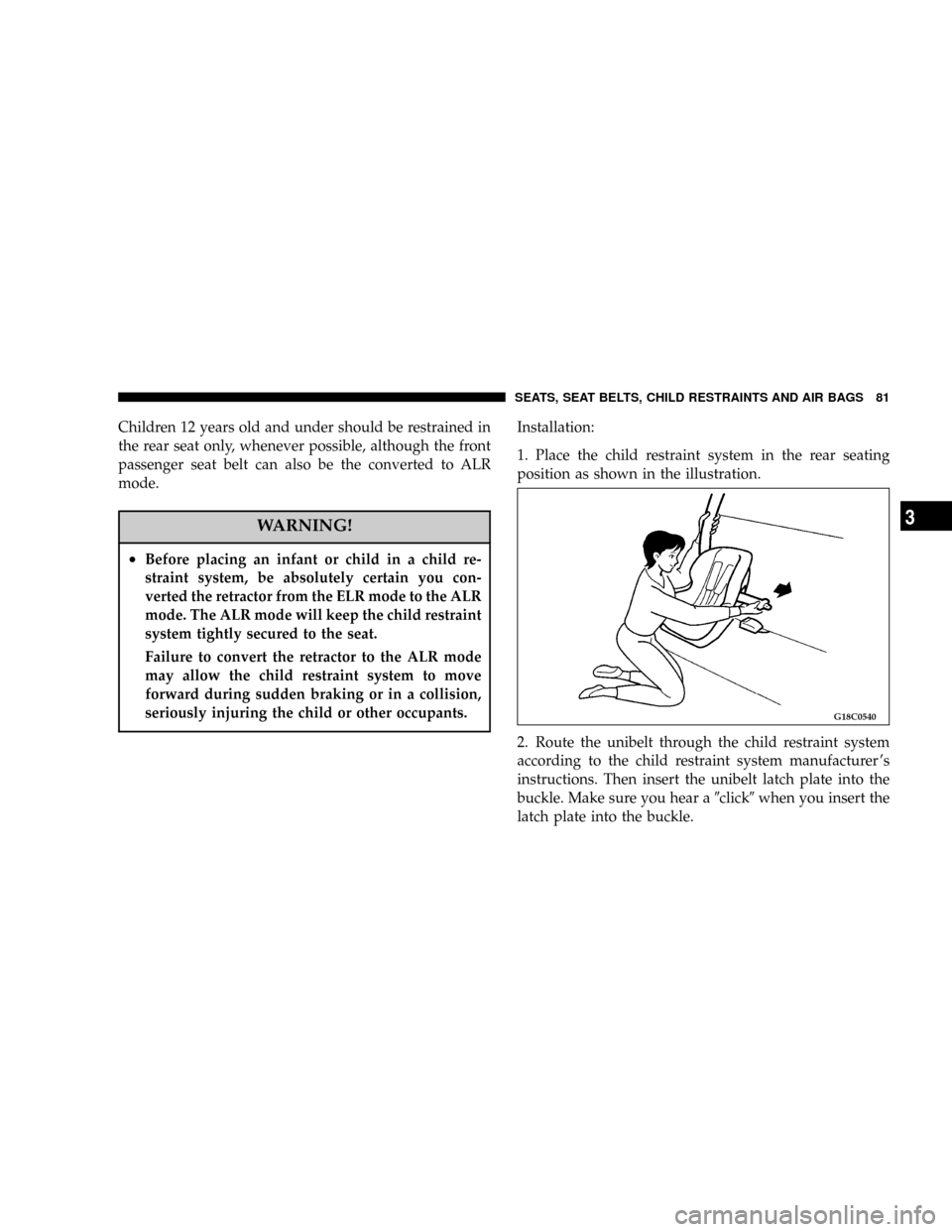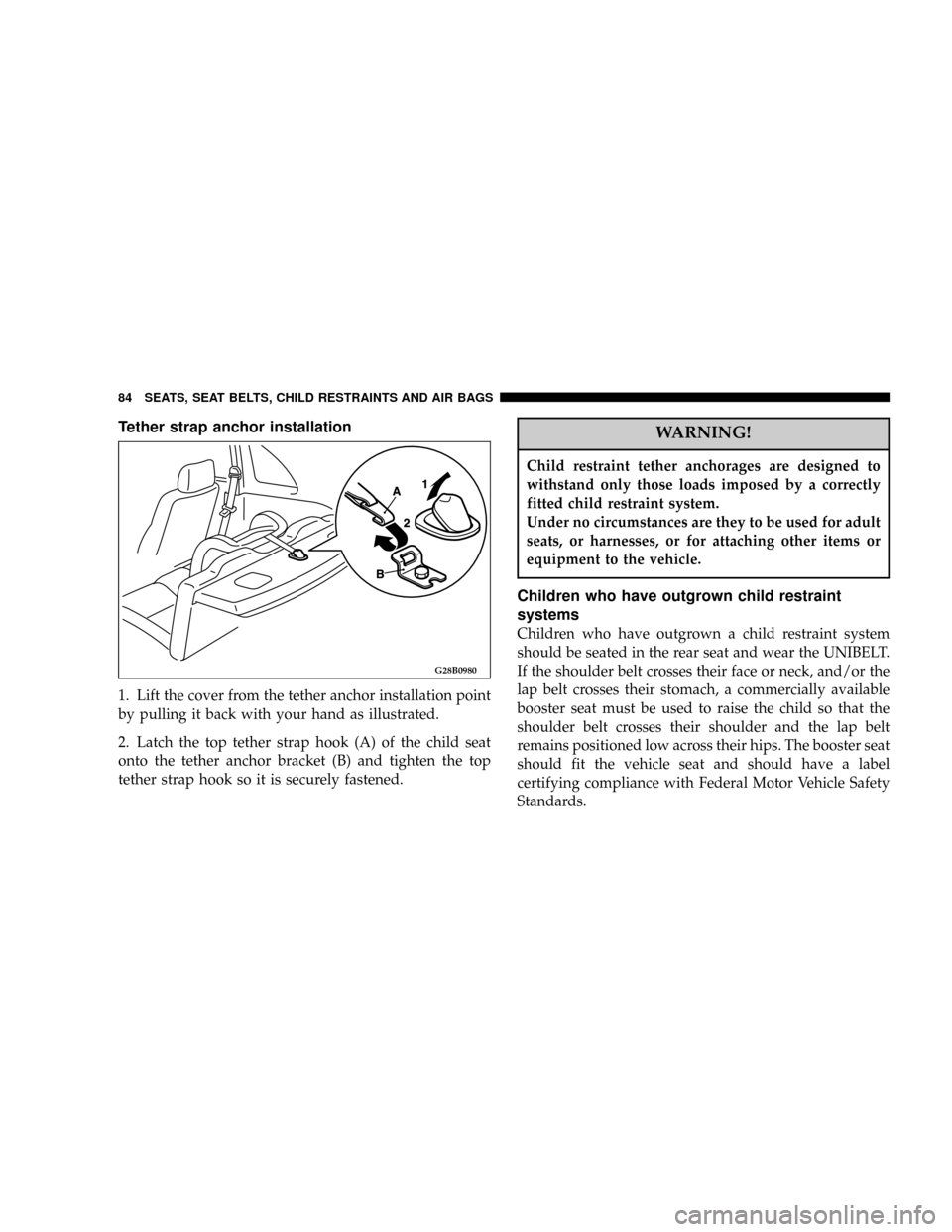Page 72 of 382

WARNING!
To reduce risk of serious injury in a collision, adjust
the anchor at a position so that the belt passes over
your shoulder, but does not touch your neck.
Always adjust the anchor when vehicle is not in
motion.
Make sure the anchor is securely latched after ad-
justment.
Enhanced Driver Seat Belt Use Reminder System
(BeltAlertŸ)
If the driver 's seat belt has not been buckled within 60
seconds of starting the vehicle and if the vehicle speed is
greater than 5 mph (8 km/h), the Enhanced Warning
System (BeltAlertŸ) will alert the driver to buckle their
seat belt. The driver should also instruct all other occu-
pants to buckle their seat belts. Once the warning is
triggered, the Enhanced Warning System (BeltAlertŸ)
will continue to chime and flash the Seat Belt Warning
Light for 96 seconds or until the driver 's seat belt is
buckled.The Enhanced Warning System (BeltAlertŸ) will be
reactivated if the driver 's seat belt is unbuckled for more
than 10 seconds and the vehicle speed is greater than 5
mph (8 km/h).
The Enhanced Warning System (BeltAlertŸ) can be en-
abled or disabled by your authorized dealer or by
following these steps:
NOTE:
The following steps must occur within the first 60
seconds of the ignition switch being turned to the ON
or START position. The manufacturer does not recom-
mend deactivating the Enhanced Warning System
(BeltAlertŸ).
·Turn the ignition switch to the OFF position, and
buckle the driver 's seat belt.
·Turn the ignition key to the ACCESSORY/RUN
position (engine does not need to be running), and
wait for the Seat Belt Warning Light to turn off.
·Within 60 seconds of starting the vehicle, unbuckle
and then re-buckle the driver 's seat belt at least three
times within 10 seconds, ending with the seat belt
buckled.
72 SEATS, SEAT BELTS, CHILD RESTRAINTS AND AIR BAGS
Page 77 of 382

WARNING!
²It is important to use an approved rear facing
infant restraint until the infant is one year old to
allow the infant's neck and spine to develop
enough to support the weight of their head in the
event of a collision.
²When installing a child restraint system, follow
the instructions provided by the manufacturer
and follow the directions in this manual. Failure
to do so can result in severe or fatal injury to your
child in a collision or sudden stop.
²After installation, push and pull the child re-
straint system back and forth, and side to side, to
see that it is firmly secured. If the child restraint
system is not installed securely, it may cause
injury to the child or other occupants in the event
of a collision or sudden stop.
²When not in use, keep your child restraint system
secured with the seat belt or remove it from the
vehicle in order to prevent it from being thrown
inside the vehicle during an accident.
NOTE: Before purchasing a child restraint system, try
installing it in the rear seat to ensure a good fit. Due to the
location of the seat belt buckles and the shape of the seat
cushion it may be difficult to securely install some child
restraint systems.
If the child restraint system can be pulled forward or to
either side easily on the seat cushion after the seat belt
has been tightened, choose another child restraint sys-
tem.
²Depending on the seating position in the vehicle and
the child restraint system that you have, the child
restraint can be attached using one of the following 2
methods:
²To the lower anchorage in the rear seat ONLY if the
child restraint complies with Federal Motor Vehicle
Satety Standard 213 (See page 78).
²To the UNIBELT (See page 80).
SEATS, SEAT BELTS, CHILD RESTRAINTS AND AIR BAGS 77
3
Page 79 of 382
Installation
1. Open the gap a little between the seat cushion (A) and
the seatback (B) with your hand to locate the lower
anchorages (C).
2. Push the child restraint system's connectors into the
lower anchorages (C) in accordance with the instructions
provided by the child restraint system's manufacturer.3. If your child restraint system requires the use of a top
tether strap, refer to ``Tether anchors for child restraint
systems'' on page 83.
4. Push and pull the child restraint system in all direc-
tions to be sure it is firmly secured.
NOTE:
²For a new child restraint system that complies with
Federal Motor Vehicle Safety Standard 213, it is not
necessary to secure the child restraint system using the
vehicle's seat belt.
G18D0240
SEATS, SEAT BELTS, CHILD RESTRAINTS AND AIR BAGS 79
3
Page 80 of 382

WARNING!
²If there is any foreign material in or around the
connectors, remove it before installing the child
restraint system. Also, make sure the seat belt is
away from, not looped through or otherwise in-
terferes with the child restraint system. If foreign
matter is not removed and/or the seat belt inter-
feres with the child restraint system, the child
restraint system will not be secured properly and
could move forward in the event of sudden brak-
ing or a collision, seriously injuring the child and
possible other vehicle occupants.
²When the vehicle is moving, do not adjust the seat
where the child restraint system is installed.
Installing a child restraint system to a UNIBELT
at the rear seat positions or the front passenger
seat (With emergency/automatic locking
mechanism)
The UNIBELT at the rear seat positions, and at the front
passenger seat, can be converted from normal Emergency
Locking retractor (ELR) mode, to Automatic Locking
Retractor (ALR) mode. It must be converted to the ALR
mode when installing a child restraint system.
G18C0790
80 SEATS, SEAT BELTS, CHILD RESTRAINTS AND AIR BAGS
Page 81 of 382

Children 12 years old and under should be restrained in
the rear seat only, whenever possible, although the front
passenger seat belt can also be the converted to ALR
mode.
WARNING!
²Before placing an infant or child in a child re-
straint system, be absolutely certain you con-
verted the retractor from the ELR mode to the ALR
mode. The ALR mode will keep the child restraint
system tightly secured to the seat.
Failure to convert the retractor to the ALR mode
may allow the child restraint system to move
forward during sudden braking or in a collision,
seriously injuring the child or other occupants.
Installation:
1. Place the child restraint system in the rear seating
position as shown in the illustration.
2. Route the unibelt through the child restraint system
according to the child restraint system manufacturer 's
instructions. Then insert the unibelt latch plate into the
buckle. Make sure you hear a9click9when you insert the
latch plate into the buckle.
G18C0540
SEATS, SEAT BELTS, CHILD RESTRAINTS AND AIR BAGS 81
3
Page 82 of 382
3. To activate the ALR mode, slowly pull the shoulder
part of the belt all the way out until it stops, then let the
belt feed back into the retractor.
4. After the belt has retracted, tug on it. If the belt is
locked, you will not be able to pull it out. If you can pull
the belt out, it is not locked and not in the ALR mode. You
will need to repeat steps 3 and 4.5. After confirming that the belt is locked, grab the
shoulder part of the belt near the buckle and pull up to
remove any slack from the lap part of the belt. Remem-
ber, if the lap part of the belt is not tight, the child
restraint system will not be secure. It may help to put
weight on the child restraint system and/or push on its
seatback while pulling up on the belt (see illustration).
G18C0550G18C0560
82 SEATS, SEAT BELTS, CHILD RESTRAINTS AND AIR BAGS
Page 83 of 382
6. If your child restraint system requires the use of a top
tether strap, refer to ªAnchors for the child restraint
systemº on page 83.
7. Before putting the child in the restraint, push and pull
the restraint in all directions to be sure it is firmly secure.
Do this before each use. If the child restraint system is not
firmly secure, repeat steps 1 through 6.
8. To remove a child restraint system and deactivate the
ALR mode, remove the child from the restraint. Unlatch
the buckle, remove the belt from the restraint and let the
belt fully retract.Tether anchors for the child restraint system
In compliance with the Federal Motor Vehicle Safety
Standards, your vehicle has 3 attachment points on the
rear shelf, located behind the top of your rear seat. For
securing a child seat tether strap to each of the 3 rear
seating positions (2 outer and 1 center) in your vehicle.
G28B1090
SEATS, SEAT BELTS, CHILD RESTRAINTS AND AIR BAGS 83
3
Page 84 of 382

Tether strap anchor installation
1. Lift the cover from the tether anchor installation point
by pulling it back with your hand as illustrated.
2. Latch the top tether strap hook (A) of the child seat
onto the tether anchor bracket (B) and tighten the top
tether strap hook so it is securely fastened.
WARNING!
Child restraint tether anchorages are designed to
withstand only those loads imposed by a correctly
fitted child restraint system.
Under no circumstances are they to be used for adult
seats, or harnesses, or for attaching other items or
equipment to the vehicle.
Children who have outgrown child restraint
systems
Children who have outgrown a child restraint system
should be seated in the rear seat and wear the UNIBELT.
If the shoulder belt crosses their face or neck, and/or the
lap belt crosses their stomach, a commercially available
booster seat must be used to raise the child so that the
shoulder belt crosses their shoulder and the lap belt
remains positioned low across their hips. The booster seat
should fit the vehicle seat and should have a label
certifying compliance with Federal Motor Vehicle Safety
Standards.
G28B0980
84 SEATS, SEAT BELTS, CHILD RESTRAINTS AND AIR BAGS